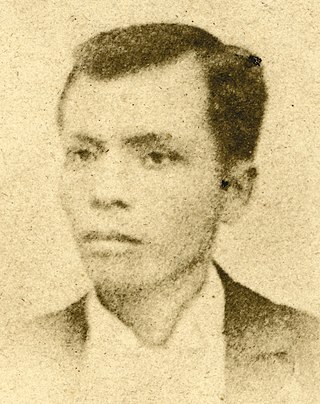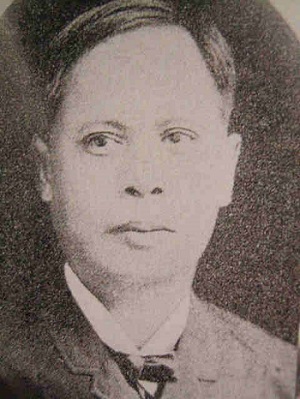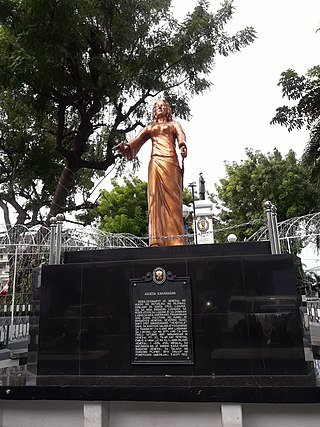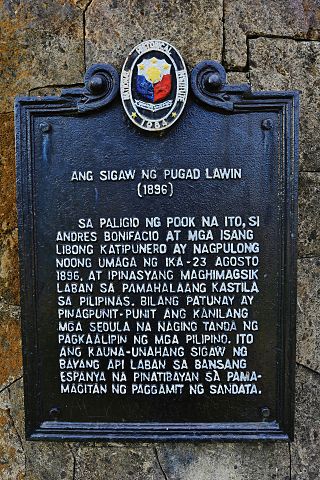
Emilio Aguinaldo y Famy was a Filipino revolutionary, statesman, and military leader who became the first president of the Philippines (1899–1901), and the first president of an Asian constitutional republic. He led the Philippine forces first against Spain in the Philippine Revolution (1896–1898), then in the Spanish–American War (1898), and finally against the United States during the Philippine–American War (1899–1901). Though he was not recognized outside of the revolutionary Philippines, he is regarded in the Philippines as having been the country's first president during the period of the First Philippine Republic.

The Katipunan, officially known as the Kataastaasang Kagalanggalangang Katipunan ng mga Anak ng Bayan and abbreviated as the KKK, was a revolutionary organization founded in 1892 by a group of Filipino nationalists Deodato Arellano, Andrés Bonifacio, Valentin Diaz, Ladislao Diwa, José Dizon, and Teodoro Plata. Its primary objective was achieving independence from the Spanish Empire through an armed revolution. It was formed as a secret society before its eventual discovery by Spanish authorities in August 1896. This discovery led to the start of the Philippine Revolution.

Andrés Bonifacio y de Castro was a Filipino revolutionary leader. He is often called "The Father of the Philippine Revolution", and considered a national hero of the Philippines.

The Philippine Revolution was a war of independence waged by the revolutionary organization Katipunan against the Spanish Empire from 1896 to 1898. It was the culmination of the 333-year colonial rule of Spain in the archipelago. The Philippines was one of the last major colonies of the Spanish Empire, which had already suffered a massive decline in the 1820s. Cuba rebelled in 1895, and in 1898, the United States intervened and the Spanish soon capitulated. In June, Philippine revolutionaries declared independence. However, it was not recognized by Spain, which sold the islands to the United States in the Treaty of Paris.
Tagalog Republic is a term used to refer to two revolutionary governments involved in the Philippine Revolution against the Spanish Empire and the Philippine–American War. Both were connected to the Katipunan revolutionary movement.

Deodato Arellano y de la Cruz was a Filipino propagandist and the first president of the Katipunan, which was founded at his home in Azcarraga Street, Manila. He was first to be given the title Supremo by the Katipunan. After studying bookkeeping in Ateneo de Municipal de Manila, he became an assistant clerk for the Spanish military. He was a member of the Freemasonry in the Philippines and became involved in the Propaganda Movement.
Román Bása was a Filipino patriot who was the second Supremo or leader of the Katipunan, the secret society which sparked the Philippine Revolution against Spanish rule in 1896.

The Tejeros Convention, also referred to as the Tejeros Assembly or Tejeros Congress, was a meeting held on March 22, 1897, in San Francisco de Malabon, Cavite. This gathering brought together factions of the Katipunan, namely Magdiwang and Magdalo, and led to the establishment of a new revolutionary government that took over leadership of the Philippine Revolution, replacing the Katipunan. It followed the earlier Imus Assembly. Filipino historians regard this event as the first presidential and vice presidential elections in Philippine history, although only Katipuneros participated, not the general public.

Agueda Kahabagan y Iniquinto was a Philippine general in the Philippine Republican Army and a member of the Katipunan.

The Cry of Pugad Lawin was the beginning of the Philippine Revolution against the Spanish Empire.

Emilio Jacinto y Dizon was a Filipino general during the Philippine Revolution. He was one of the highest-ranking officers in the Philippine Revolution and was one of the highest-ranking officers of the revolutionary society Kataas-taasang, Kagalang-galang na Katipunan ng mga Anak ng Bayan, or simply and more popularly called Katipunan, being a member of its Supreme Council. He was elected Secretary of State for the Haring Bayang Katagalugan, a revolutionary government established during the outbreak of hostilities. He is popularly known in Philippine history textbooks as the Brains of the Katipunan while some contend he should be rightfully recognized as the "Brains of the Revolution". Jacinto was present in the so-called Cry of Pugad Lawin with Andrés Bonifacio, the Supremo of the Katipunan, and others of its members which signaled the start of the Revolution against the Spanish colonial government in the islands.
Críspulo Aguinaldo y Famy was a native of Kawit, Cavite the older brother of Emilio Aguinaldo and lieutenant general who heroically defended in the Battle of Pasong Santol.
This is a list of notable events that happened in the Philippines in the year 1897.

El Presidente: The Story of Emilio Aguinaldo and the First Philippine Republic, or simply El Presidente, is a 2012 Filipino biographical historical drama film written and directed by Mark Meily about the life of General Emilio Aguinaldo, the first president of the Philippine Republic. The film stars Jeorge "E.R." Ejercito Estregan in the title role, along with Nora Aunor, Christopher de Leon, Cristine Reyes, and Cesar Montano.

The Battle of Kakarong de Sili was fought on January 1, 1897, at Pandi, Bulacan, in the Philippines. The Kakarong Republic, based in the little fort in Pandi, was attacked by a force of Spaniards who massacred the Katipuneros there. At the end of the battle, General Eusebio Roque was captured by the Spaniards. The Kakarong Republic was considered the first republic formed in Bulacan and in the Philippines.
The Battle of Perez Dasmariñas was a battle of the Philippine Revolution. It occurred during the Cavite Offensive of 1897, commanded by Maj. Gen. Jose de Lachambre under Governor-General Camilo de Polavieja, as the Spanish aimed to recapture Cavite from Katipunan rebel control. Both the battle and the offensive was a success for the Spanish, and the retreat to Montalban occurred several weeks after the battle.
This is the timeline of the Philippine Revolution—the uprising that gave birth to Asia's first republic. The roots of the revolution trace back to the Cavite mutiny and subsequent execution of Gomburza in 1872, and ended with the declaration of independence from Spain in 1898.

Silvia Celeste Rabimbi Cortesi is a Filipino actress and beauty pageant titleholder who was crowned Miss Universe Philippines 2022. She represented the Philippines at Miss Universe 2022 in the United States where she was unplaced. Cortesi was previously crowned Miss Earth Philippines 2018 and represented the Philippines at Miss Earth 2018, where she finished in the top eight.

Miss Universe Philippines (MUPH) is a beauty pageant and organization that selects the Philippines' official representative to Miss Universe—one of the Big Four beauty pageants.














